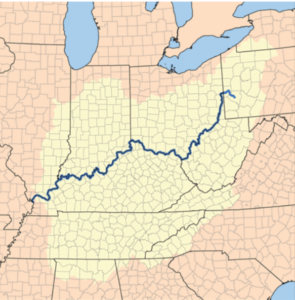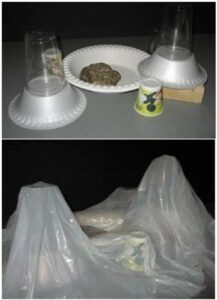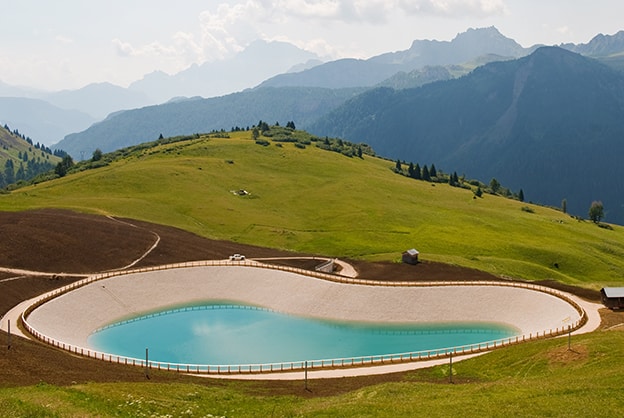Overview
STEM careers
Topic
Time
Materials
Per Whole Group:
|
Per Team:
|
Relevant Terminology

The Ohio River Watershed (yellow) spans 14 US states. Credit: Karl Musser/ Wikimedia Commons.
Watershed: An area of land where surface water from rain or melting snow comes together to drain into another body of water.
Pollution: Substances that make land, water, or air dirty and not safe or suitable to use.
Point source pollution: Pollution that can be traced back to a single source or event, such as an oil spill.
Nonpoint source pollution: Pollution that cannot be traced back to a single point or event such as agricultural runoff
Topography: The physical features of an area, both natural and artificial.
Introduce
GETTING READY
If doing this activity for around 30 participants, split up supplies in advance. Each team should get 1 tray, 1 trash bag, 1 spray bottle, 1 sponge, 3 bowls, 2 cups, and assorted rocks or foam balls. If doing this activity in a large public setting, consider keeping your supplies organized on one table and providing another space for building the watershed.
Familiarize yourself with engineering projects that affect local watersheds or waterways.
INTRODUCTION
Ask participants if they’ve ever wondered where water goes when it rains. Explain that most of it ends up in streams or rivers. An area of land that all drains to the same stream is called a watershed. We can think of a watershed as a funnel that collects water from all over and directs it to one place. Ask:
- What are some things that affect rivers or streams? (Landforms, precipitation, pollution, life, or human structures.)
- What problems might an engineer address in a watershed? (Flooding, navigation, pollution, etc.)
By understanding how watersheds work, engineers help to ensure our health, happiness, and safety.
Instructions

Before and after adding the trash bag to the landforms. Credit: Malinda Schaefer Zarske, ITL Program, College of Engineering, University of Colorado Boulder.
Divide the whole group into teams of 2–4. Explain that teams will work together to build a model watershed using the materials provided. Deliver the following instructions:
- Arrange the supplies on a tray to make interesting topographical features, such as mountains, valleys, plateaus, and so on.
- Cover the tray with a trash bag or plastic sheet and gently mold it to the objects underneath. Tape it down as needed.
- Predict what will happen to rainwater that falls on your landscape. Will it all go to the same place? How will it flow?
- Spray with water and observe. Share your results.
Ask participants to think about where they would locate a source of pollution on their landscape. They can decide if it’s a factory, a farm, or a construction site. Place a few drops of food coloring on a sponge to represent pollution and position it on top of the trash bag. Spray again and observe what happens to the food coloring.
ACTIVITY VARIATIONS
Connect several model watersheds together to make a larger area.
Create a dam or use Lego pieces to build houses. What would happen in a flood?
Guiding questions
GUIDANCE FOR YOUNGER CHILDREN
QUESTIONS TO ASK AFTER THE ACTIVITY
- Where did the water go when you sprayed your watershed?
- What happened when you introduced the pollution source to your watershed?
- If there were a lot of buildings in your watershed, how do you think they’d affect where the water goes?
- In a rainstorm, how might a watershed with mountains act differently from one that’s pretty flat?
- If you were an engineer, what solutions would you try to keep the pollution from spreading throughout your watershed?
GUIDANCE FOR OLDER YOUTH AND ADULTS
QUESTIONS TO ASK AFTER THE ACTIVITY
- How does the topography of your watershed affect the flow of water? If you made steep slopes, how would a low hill change the flow, and vice versa?
- How does your model watershed inform your thinking about the watershed you live in and how people affect it?
- What would happen if you doubled the amount of water and added it to your watershed? How can engineers help prevent floods?
- What happened when you introduced the pollution source to your watershed?
- How might this model help an engineer come up with ways to reduce or eliminate pollution? What ideas does your model give you?
Engineering & science connections
GUIDANCE FOR YOUNGER CHILDREN
Engineering Connections
People use water for drinking, washing, cooking, farming, landscaping, swimming, fishing, and so much more. Engineers try to make sure that there’s enough water for all of these purposes by managing its flow, and working to direct and store water. Some of the earliest engineers designed aqueducts to help transport water to ancient civilizations. Aqueducts are channels that carry water from one place to another. You can still see ancient aqueducts in places such as Rome and Jerusalem. Today, engineers use dams, canals, levees, pumps, and pipelines to manage water movement and storage in a watershed.
Engineers also help us to keep our water clean. They design and construct sewage treatment plans to clean the water that goes down our drains. They have also figured out how to clean up oil spills and other forms of water pollution.
Science Connections
Do you think you live in a watershed? In fact, everyone on Earth does! Every drop of rain eventually drains into a body of water that leads to a bigger body of water and ultimately empties into a very large body of water. Watersheds are typically named for the body of water that precipitation (rain or snow) drains into. For example, Pittsburgh, Pennsylvania, is part of the Ohio River Watershed because all the water that falls in that region ends up in the Ohio River.
Pollution in a watershed comes from many sources. While some pollution refers to toxic chemicals that are dangerous to people and animals, a lot of pollution is simply too much of something in the water that is usually safe. For example, dirt is not usually toxic, but if too much gets into the water from construction or farming, it makes the water cloudy and kills aquatic plants. Aquatic plants are one of nature’s filters—so the water gets even dirtier without them.
GUIDANCE FOR OLDER YOUTH AND ADULTS
Engineering Connections
People have been trying to control water for centuries in order to use it for many purposes, among them creating energy, irrigating crops, and transporting coal and lumber. Engineers need to understand how water flows in watersheds so that they can design solutions and inventions to help us accomplish these tasks and ultimately make life easier. Engineers try to control water to reduce flooding and protect homes and businesses. Engineers also find ways to treat water used in factories or coming out of sewers so that it is clean and environmentally healthy.
Some of the earliest engineers designed aqueducts to help transport water to ancient civilizations. Aqueducts are channels that convey water from one place to another. Ancient aqueducts can still be seen today in places such as Rome and Jerusalem.
Science Connections
Much of the science of watersheds focuses on how to keep them clean and healthy. Pollution in a watershed comes from many sources. Sometimes we can trace the pollution back to a single source, like an oil spill or construction project. We call this point source pollution, and we can monitor it and do our best to clean it up. Nonpoint source pollution is the combination of small amounts of pollution in watersheds that ends up in the water. This pollution could be fertilizer and pesticides running off of lawns and gardens, oil and salts washing off of roads, and even litter being washed into rivers.
While some pollution refers to toxic chemicals that are dangerous in all circumstances, a lot of pollution is simply too much of a usually safe substance getting into the water. Too much dirt from construction or farming runoff can make the water too cloudy, killing off aquatic plants. Fertilizer in runoff causes the opposite: a high growth level of algae plants that live in water. Algae cover the water in an event called an algal bloom. When the algae die, the oxygen in the water is used by decomposers, which leads to fish dying off.
The source of this material is the TeachEngineering digital library collection at www.TeachEngineering.org. All rights reserved.
www.teachengineering.org/sprinkles/view/cub_catchwater
Supplemental content adapted for Dream Big Activities by the Carnegie Science Center.


0 Comments